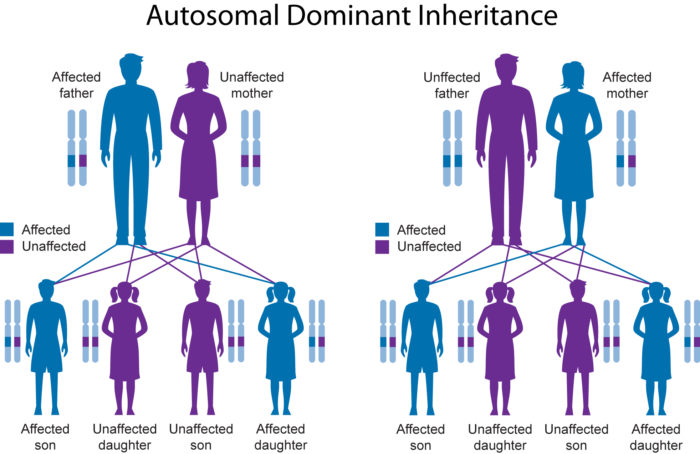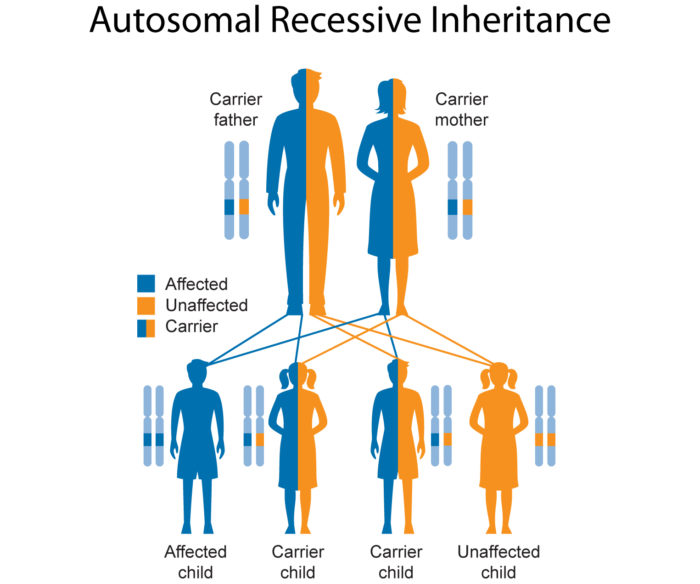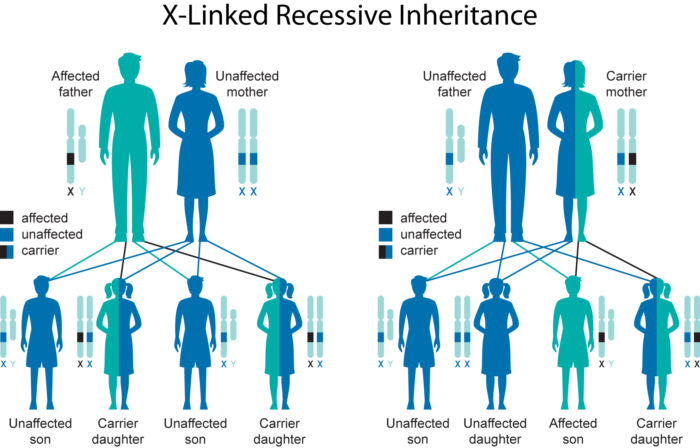All ectodermal dysplasias are genetic disorders, which means that they can be passed on to children by parents. However, it is also possible for a child to be the first person in the family to be affected by an ectodermal dysplasia.
Understanding Chromosomes and Genes
The body is composed of billions of cells. Within the cells, are small thread-like structures called chromosomes. We have 23 pairs of chromosomes – two of each. We inherit one set from our mother and one set from our father. All of the chromosomes together make up our entire genetic information and can be thought of as an encyclopedia, or set of instructions, for how our bodies function. Chromosomes are like individual volumes of the encyclopedia set. Each contains a portion of our genetic information, in the form of genes.
Genes are the instructions that tell our bodies how to work properly. If there is a change in any of our genes, it may affect what that gene is supposed to do and may cause different health or medical problems. Genes are composed of deoxyribonucleic acid or DNA, which are the letters of the genetic alphabet. DNA is passed from one generation to the next in sperm cells from fathers and egg cells from mothers. You can think of a gene as a sentence in a book. If there is a change in any of the letters or if any of the words are missing, it will affect what that sentence was supposed to say. Similarly, misspellings of any of the genes can affect how the gene works and may cause problems with normal health and development.
Genetic Variants
The ectodermal dysplasias are caused by changes or misspellings in our genes. In medical terms, these are often called “mutations”. Many genetic changes are unique to a family. However, even in families and individuals who have the exact same mutation, there can be variability in how the condition affects each family member. Therefore, it can be difficult to predict, just based on the genetic test result, how the genetic change may affect you personally.
If the DNA we inherit has no mutations, we are programmed to develop normally. If there is a mutation in one of the genes in the DNA (our mother’s or our father’s), we are programmed to develop abnormally. If a change occurs in the DNA of one of the 22 pairs that have virtually nothing to do with determining gender, is said to be autosomal. A mutation in the DNA of the sex pair is said to be X-linked.
It is important to remember that you cannot choose or modify the genes that you or your children have. Therefore, there is nothing that parents did or did not do to cause these genetic changes to happen.
Learn More About Genetic VariantsInheritance and Recurrence Risk
The odds that parents have affected children depend on the inheritance pattern of the type of ectodermal dysplasia that affects the family.

When the ectodermal dysplasia is inherited in an autosomal dominant manner, the parent who is affected has a single copy of the abnormal gene and may pass it on to children.
Regardless of the gender of the parent or the child, there is a 50% chance (or 1 in 2) for each child to inherit the abnormal gene. And all children who receive the abnormal gene will be affected.

When the ectodermal dysplasia in the family is inherited in an autosomal recessive manner, in order to be affected with the condition, you must have two abnormal copies of the gene. Parents will have one normal copy of the gene and one abnormal copy. Therefore, parents are called “carriers” of the condition, but are not affected. If both parents are carriers of the same genetic condition, there is a 25% (or 1 in 4) chance that each child will be affected.
There is then a 50% chance that the child will be an unaffected carrier, like the parents; and a 25% chance that they will have two normal copies of the gene and be unaffected.

When the ectodermal dysplasia is inherited in an X-linked manner, the gene that is altered is located on the X chromosome.
Since men only have one X chromosome, they will be more affected than females , who have two X chromosomes. A woman’s other X chromosome (and gene) will compensate for the gene that is altered. These females can show no apparent visible symptoms, few symptoms or all the symptoms as an affected male. If a woman is a carrier of an X-linked ectodermal dysplasia, there is a 50% chance that each son will be affected and a 50% chance that each daughter will be a carrier, like the mother.
If a man has the abnormal gene, he will be affected. And all of his daughters will be carriers. Since the gene is on the X chromosome, none of his sons will be affected because they inherit the Y chromosome from their father.
New Mutation, “de Novo”
Generally, when a new mutation has occurred, there is a small chance (<1%) that the parents will have another child affected with the same condition. That child, even if not personally affected, may have an increased chance of having a child of their own with the same condition. The actual risk depends on the type of ectodermal dysplasia that you or your child has.
Watch the Webinar
Hosted by NFED staff and Dorothy Katherine Grange, M.D., our webinar covers an overview of genetics as it relates to ectodermal dysplasias. What are genetic conditions? How are they passed down? Is testing available? Watch the one-hour webinar to find answers.
Get the WebinarResources to Learn More
- Genetic Counseling
- Genetic Carriers: How to Tell Your Partner
- Frequently asked questions about genetic testing
- To learn more about genetics, visit Genes in Life or Genetics Home Reference.
- For help in finding a genetic counselor, try the National Society of Genetic Counselors.
- Download the RARE Toolkit, Genetic Testing: Is This My Path to a Diagnosis?
- View the Global Genes Webinar, How to Discuss Genetic Disease with Your Loved Ones